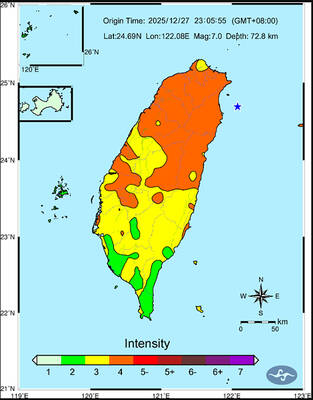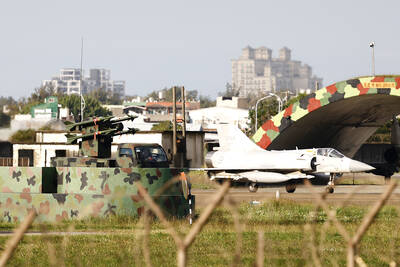The nation’s five special municipalities, home to 60 percent of the population, began operations yesterday, starting a new phase in Taiwan’s administrative history.
Taipei, New Taipei City (新北市, the proposed name of the upgraded Taipei County), Greater Taichung, Greater Tainan and Greater Kaohsiung began operating as megacities almost one month after the residents of the five municipalities, including Taipei City, chose their mayors in high-profile elections on Nov. 27.
In addition to Taipei City and New Taipei City, the other three cities were expanded through a merger of two administrative districts.
Greater Taichung is the result of a merger of Taichung City and Taichung County; Greater Tainan a merger of Tainan City and Tainan County; and Greater Kaohsiung a merger of Kaohsiung City and Kaohsiung County.
According to Minister of the Interior Jiang Yi-huah (江宜樺), the change is aimed at making the five megacities “spearheads of Taiwan’s regional development” and “cores of the three living areas of northern, central and southern Taiwan.”
The new system is not likely to affect the everyday life of the 13.7 million residents in the five cities, but integrating local governments and administrative branches are likely to present a big challenge in the cities where mergers took place.
Greater Tainan and Greater Kaohsiung both split their agencies into two parts to keep them in their original office buildings, while Greater Taichung opted for three office buildings in different parts of its administrative area.
Effective yesterday, townships (鄉鎮) and county-administered cities (市) are renamed “districts (區)” and villages (村) will be renamed “boroughs (里).” District chiefs are to be appointed by mayors rather than being elected, as was previously the case.
Township councils have been disbanded, which means thousands of township and city councilmen have lost their jobs.
Newly elected mayors have focused on the financial aspects of the new city governments. Taichung City Mayor Jason Hu (胡志強) publicly expressed concern that the city would be in financial trouble if budget allocating procedures and tax regulations were not reformed.
New Taipei City faced a different problem — trying to figure out what to call itself in English. Mayor-elect Eric Chu (朱立倫) has announced that he wanted the new city’s English name to be “New Taipei City,” because Sinbei means “new Taipei” in Chinese.
However, the move was blocked by the Ministry of the Interior for now, with Deputy Interior Minister Chien Tai-lang (簡太郎) saying the ministry would discuss the proposal with Chu at a later date.

Taiwan is gearing up to celebrate the New Year at events across the country, headlined by the annual countdown and Taipei 101 fireworks display at midnight. Many of the events are to be livesteamed online. See below for lineups and links: Taipei Taipei’s New Year’s Party 2026 is to begin at 7pm and run until 1am, with the theme “Sailing to the Future.” South Korean girl group KARA is headlining the concert at Taipei City Hall Plaza, with additional performances by Amber An (安心亞), Nick Chou (周湯豪), hip-hop trio Nine One One (玖壹壹), Bii (畢書盡), girl group Genblue (幻藍小熊) and more. The festivities are to

Auckland rang in 2026 with a downtown fireworks display launched from New Zealand’s tallest structure, Sky Tower, making it the first major city to greet the new year at a celebration dampened by rain, while crowds in Taipei braved the elements to watch Taipei 101’s display. South Pacific countries are the first to bid farewell to 2025. Clocks struck midnight in Auckland, with a population of 1.7 million, 18 hours before the famous ball was to drop in New York’s Times Square. The five-minute display involved 3,500 fireworks launched from the 240m Sky Tower. Smaller community events were canceled across New Zealand’s

AFTERMATH: The Taipei City Government said it received 39 minor incident reports including gas leaks, water leaks and outages, and a damaged traffic signal A magnitude 7.0 earthquake struck off Taiwan’s northeastern coast late on Saturday, producing only two major aftershocks as of yesterday noon, the Central Weather Administration (CWA) said. The limited aftershocks contrast with last year’s major earthquake in Hualien County, as Saturday’s earthquake occurred at a greater depth in a subduction zone. Saturday’s earthquake struck at 11:05pm, with its hypocenter about 32.3km east of Yilan County Hall, at a depth of 72.8km. Shaking was felt in 17 administrative regions north of Tainan and in eastern Taiwan, reaching intensity level 4 on Taiwan’s seven-tier seismic scale, the CWA said. In Hualien, the

‘IRRESPONSIBLE’: Beijing’s constant disruption of the ‘status quo’ in the Taiwan Strait has damaged peace, stability and security in the Indo-Pacific region, MOFA said The Presidential Office yesterday condemned China’s launch of another military drill around Taiwan, saying such actions are a “unilateral provocation” that destabilizes regional peace and stability. China should immediately stop the irresponsible and provocative actions, Presidential Office spokeswoman Karen Kuo (郭雅慧) said, after the Chinese People’s Liberation Army (PLA) yesterday announced the start of a new round of joint exercises around Taiwan by the army, navy and air force, which it said were approaching “from different directions.” Code-named “Justice Mission 2025,” the exercises would be conducted in the Taiwan Strait and in areas north, southwest, southeast and east of Taiwan